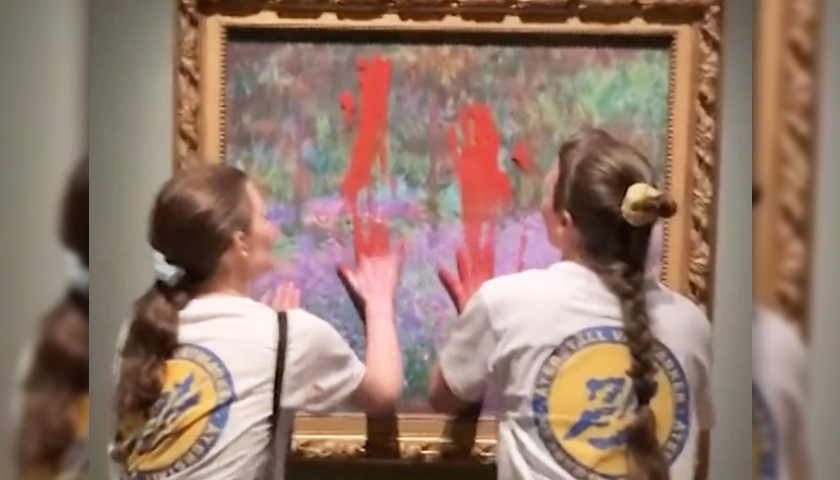by Addison Smith
This week, the world witnessed yet another act of vandalism in the name of climate change when two Swedish nurses tried to glue themselves to a Monet art piece in Stockholm’s National Museum, then smear it with red paint.
Two women were detained in Stockholm after they threw “some kind of paint" at a painting by French artist Claude Monet and then glued themselves to the frame, Sweden's National Museum said on Wednesday.https://t.co/wsoMdHndq0 pic.twitter.com/TP54p60DrC
— The Associated Press (@AP) June 15, 2023
The painting was reportedly protected by a glass shield. But committing such acts – with more damaging consequences – appears to be a new tactic, or trend, among climate activists.
The trend seems to have started last year when two activists – including one who appeared to be wearing a “Just Stop Oil” T-shirt – splashed cans of what appeared to be tomato soup on a Van Gogh painting in London. They later sat down and apparently glued their hands to a wall.
Since then, multiple other paintings and sculptures around the world have been similarly targeted.
But the Van Gogh attack, in particular, elicited several articles and essays published by mainstream media outlets that appeared to either be directly supporting the vandalism or questioning whether it was justified.
Media Research Center’s Curtis Houck called the pattern “enraging” and criticized the “liberal media” for “embracing vandalism against priceless paintings,” in a comment to Just The News.
Here are five times the mainstream media appeared to have done so:
1. MSNBC: “Why the climate art protests are so powerful”
Responding to last October’s viral story about the two environmentalists’ attack on Van Gogh’s “Sunflowers” painting, MSNBC editor and opinion writer Zeeshan Aleem said he “cannot condemn” the vandals because their “premise is sound” about the climate “disaster” and “there is something brilliant” about it “as a form of performance art.”
One estimate has the painting worth $100 million.
“Next time you see one of these protests, consider setting aside questions of activist efficacy, sitting with the emotions you feel, and letting them move you to action,” he concluded.
2. The Guardian: “Do we really care more about Van Gogh’s sunflowers than real ones?”
Columnist George Monbiot also focused on the Van Gogh attack in his related op-ed in which he seemed to mock negative criticism of it and wrote, “‘respectable’ protest is roundly ignored.”
“What does it take? How far must we go to alert other people to the scale of the crisis we face? Only one answer is clear: further than we have yet gone,” he also wrote. “Something must shake us out of our stupor.”
Monbiot also tried to suggest proponents of fossil fuel are perhaps to blame, asking whether the “criminals here” are “those seeking to prevent the vandalism of the living planet or those facilitating it?”
3. ABC News: “Is eco-vandalism an effective way to raise awareness about climate change? Experts weigh in.”
A story published by the major news organization in November 2022 began by stating the vandalism is an “urgent message” about the “global climate emergency” being sent by the activist groups, which the outlet named “eco-vandalism.”
ABC reporter Julia Jacobo interviewed psychiatrist Lise Van Susteren. In what appeared to be her paraphrasing Van Susteren’s comments, Jacobo wrote that the vandals aren’t trying to “permanently destroy” or target “climate deniers,” but were simply “expressing their eco-distress.”
Jacobo included comments from other “experts” on the subject who all appeared to uniformly sympathize with the de-facings, using such phrases as “confrontational activism” and seemingly justifying the publicity stunts because of the “media attention” they draw.
4. Vox: “Can art destruction save us from climate destruction?”
Vox Media also responded to the Van Gogh attack with a story by producer Haleema Shah, who interviewed the spokeswoman for the group Just Stop Oil, Emma Brown, who carried out the vandalism.
In the interview, Shah highlighted Brown’s view that “targeting something that is precious and valuable” is necessary to “shock and discomfort” people into adopting their climate “catastrophe” concerns.
The story also includes a transcript of an interview with author David Freedberg, who was asked “how effective” the “destruction of art” is in advancing the climate movement’s goal.
He replied “very effective” but acknowledged that depriving people of such art would be a “great shame” and that it should be left alone “for the most part.”
5. The Guardian (again): “Art attack: can vandalism be justified to save the planet?”
On its website, The Guardian publishes what are effectively op-eds in an open-submission section called “Letters.” One section last year included a series of letters from people who all seemed to commiserate with the attempt to damage or destroy art to bring attention to climate change.
The first writer offered slight pushback against the Van Gogh tomato soup episode, calling it “misguided” but affirmed that she’s “fully supportive of the Just Stop Oil campaign” that carried it out, and acknowledged the “need for rousing tactics.”
Another writer theorized how Van Gogh would answer whether art is “worth more” than life, claiming the artist’s work “suggests that he would say that life … is worth more than a particular artifact.”
A third praised The Guardian op-ed by Monbiot (No. 2 on the list) by agreeing that “protests will be ignored unless they cross a line that many find unacceptable.”
– – –
Addison Smith is a reporter at Just the News. Follow Addison on Twitter.
Photo “Claude Monet Painting Vandalism” by The Associate Press.








